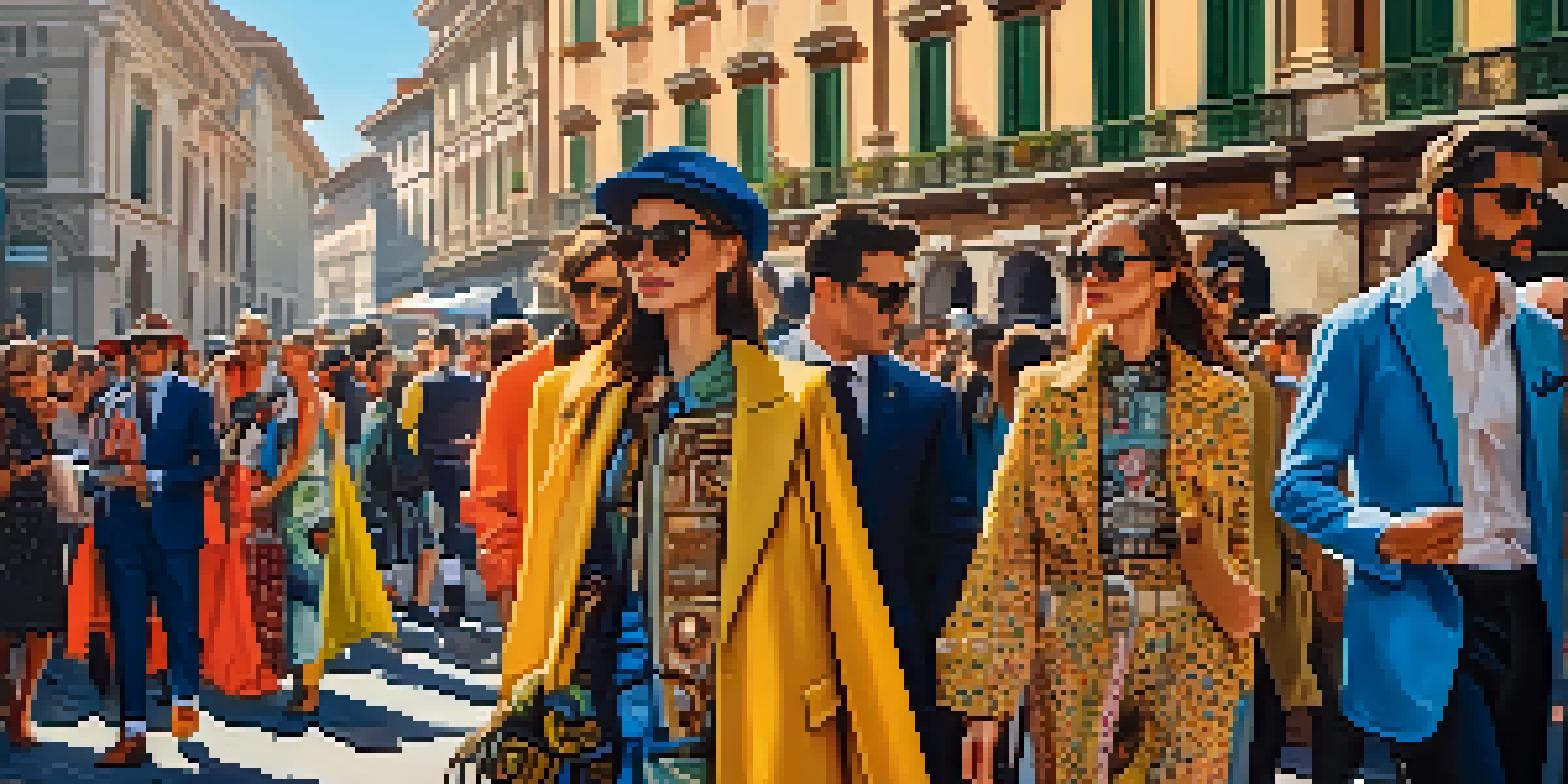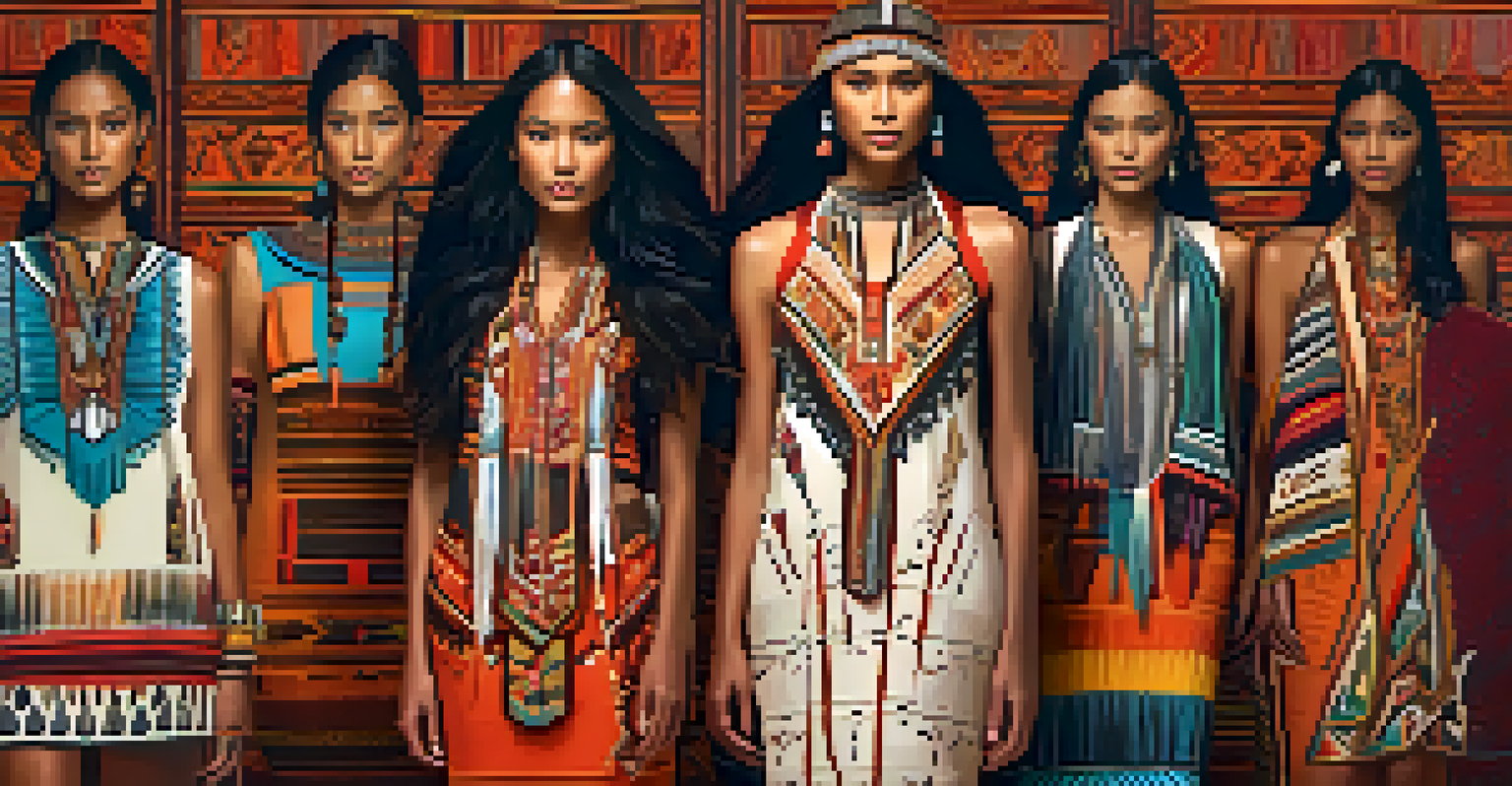Global Fashion Weeks: Showcasing Cultural Diversity in Styles

The Role of Global Fashion Weeks in Cultural Exchange
Global Fashion Weeks serve as a vibrant platform for cultural exchange, showcasing the unique styles of various regions. Designers from all over the world come together to present their collections, offering a glimpse into their cultural heritage. This melting pot of creativity not only promotes diversity but also fosters understanding among different cultures.
Fashion is the armor to survive the reality of everyday life.
For example, during Paris Fashion Week, you might see traditional Japanese kimonos reimagined with a modern twist. This not only highlights the versatility of fashion but also pays homage to the rich history behind these garments. Such interactions between different cultures encourage collaboration and innovation in the fashion industry.
Ultimately, these events remind us that fashion is more than just clothing; it's a medium through which stories are told and cultures are celebrated. Through this lens, we can appreciate the artistry that comes from blending traditional elements with contemporary design.
Highlighting Indigenous Styles in Fashion Weeks
Indigenous designers have increasingly taken center stage at Global Fashion Weeks, bringing their unique perspectives and traditional designs to the forefront. This representation not only enriches the global fashion narrative but also helps preserve and promote indigenous cultures. By showcasing their work, these designers challenge the mainstream fashion norms and introduce audiences to their rich heritage.

For instance, in recent years, designers from Indigenous communities have incorporated traditional motifs and techniques into their collections. This blend of old and new not only captivates fashion enthusiasts but also educates the wider public about these cultures. It's a beautiful reminder of how fashion can serve as a bridge between history and modernity.
Cultural Exchange in Fashion Weeks
Global Fashion Weeks showcase diverse styles, fostering cultural understanding and collaboration among designers.
Furthermore, when Indigenous designers are celebrated on such prestigious platforms, it empowers their communities and inspires future generations. This recognition fosters pride in cultural identity and encourages a dialogue about the importance of preserving these invaluable traditions.
Sustainability and Cultural Authenticity in Fashion
Sustainability has become a crucial theme in Global Fashion Weeks, with many designers incorporating eco-friendly practices into their collections. This shift not only addresses pressing environmental concerns but also highlights the importance of cultural authenticity. By using traditional, sustainable materials, designers can honor their heritage while also promoting responsible fashion.
Fashion can be bought. Style one must possess.
For example, designers from Africa often use locally sourced fabrics and traditional dyeing techniques, ensuring that their work supports local economies and preserves age-old craftsmanship. This approach resonates with consumers who are increasingly seeking out ethically made clothing. It also demonstrates that sustainable fashion can be both stylish and culturally significant.
As audiences become more conscious of their fashion choices, the demand for transparency in production processes grows. This trend encourages designers to share their stories and the cultural significance behind their materials, ultimately enriching the consumer experience and fostering a deeper appreciation for the artistry involved.
Fashion Weeks as a Reflection of Social Movements
Global Fashion Weeks often mirror the social movements and cultural conversations happening around the world. Designers use their platforms to advocate for various causes, from gender equality to environmental justice, through their collections. This intersection of fashion and activism brings attention to important issues and encourages solidarity among diverse communities.
For instance, during New York Fashion Week, several designers have dedicated their shows to raise awareness about climate change and its impact on vulnerable populations. By incorporating messages of social change into their designs, they not only captivate their audience but also inspire them to take action. This practice shows that fashion is not just about aesthetics; it can be a powerful tool for activism.
Indigenous Representation in Fashion
Indigenous designers are increasingly highlighted at Global Fashion Weeks, bringing their rich heritage and challenging mainstream norms.
As designers continue to engage with contemporary social issues, they create a dialogue that resonates far beyond the runway. This engagement fosters a sense of community and shared purpose among fashion enthusiasts, encouraging them to think critically about the impact of their choices.
The Global Influence of Street Style at Fashion Weeks
Street style has emerged as a significant influence on Global Fashion Weeks, showcasing the organic creativity of everyday individuals. This grassroots fashion movement highlights the diversity of personal styles and cultural expressions found in urban environments. As spectators and influencers showcase their unique looks, they contribute to the evolving narrative of fashion.
For example, during Milan Fashion Week, the streets become a runway, where attendees flaunt their eclectic outfits, often inspired by their cultural backgrounds. This phenomenon not only impacts designers but also inspires trends that originate from local communities. It bridges the gap between high fashion and everyday wear, making style more accessible and relatable.
Moreover, the celebration of street style at these events underscores the idea that fashion is for everyone, regardless of their background. It encourages individuals to embrace their unique identities and express themselves through their clothing, ultimately creating a more inclusive fashion landscape.
Emerging Designers Bringing Fresh Perspectives
Global Fashion Weeks are crucial for emerging designers who bring fresh perspectives and innovative ideas to the fashion scene. These platforms provide an opportunity for new talent to showcase their work, often reflecting the cultural narratives of their backgrounds. By amplifying these voices, the fashion industry becomes more dynamic and representative of global diversity.
For instance, many up-and-coming designers from Asia and Africa are reinterpreting traditional styles through a contemporary lens, captivating audiences with their unique visions. Their collections often tell compelling stories that resonate with various cultural contexts, enriching the overall experience of Fashion Weeks. This infusion of new ideas is essential for the growth and evolution of fashion.
Diversity and Inclusion's Future
The fashion industry is evolving towards greater diversity and inclusion, recognizing the importance of representation in Global Fashion Weeks.
Additionally, as established designers begin to collaborate with emerging talents, the industry fosters a culture of mentorship and shared creativity. This collaboration not only benefits the designers but also enhances the richness of the fashion narrative, making it more inclusive and diverse.
The Future of Fashion Weeks: Diversity and Inclusion
As we look toward the future, the importance of diversity and inclusion in Global Fashion Weeks cannot be overstated. There's a growing recognition that representation matters, and the industry is gradually moving towards a more inclusive model. This shift not only celebrates different cultures but also acknowledges the voices that have historically been marginalized in fashion.
Fashion Weeks are beginning to feature a broader range of body types, ethnicities, and cultural backgrounds, making strides toward a more equitable representation. This change resonates with consumers who crave authenticity and connection in the brands they support. By embracing diversity, the fashion industry can cultivate a more loyal and engaged audience.

Ultimately, the future of fashion lies in its ability to adapt and reflect the world around us. By prioritizing cultural diversity and inclusion, Global Fashion Weeks can continue to be a beacon of creativity and innovation, inspiring generations to come.